
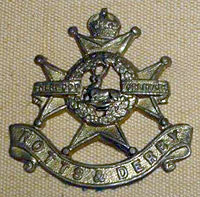
Officers' economy cap badge (1914-1919)
The history of the Worcestershire and Sherwood Foresters Regiment (29th/45th foot) is a complicated amalgamation of regiments; The 29th (Worcestershire) Regiment of Foot; 36th (Herefordshire) Regiment of Foot; 45th (Nottinghamshire) Regiment of Foot and 95th (Derbyshire) Regiment of Foot, formed over a period of 300 years culminating in December 2004 in a complete change of name becoming The Mercian Regiment (Worcesters and Foresters) along with the 1st Battalion (Cheshire) and the 3rd Battalion (Staffords).
In 1782 individual Regiments, many named after their Colonel, began to be linked territorially to counties for example 29th was linked to Worcestershire; 36th to Herefordshire; 45th to Nottinghamshire and the 95th with Derbyshire. All regiments saw action in the world’s war zones during the eighteenth and nineteenth centuries, including the American War of Independence, the French Revolutionary Wars, the Peninsular War, Spain and India.
The title ‘Sherwood Foresters’ was granted to the 45th in 1866 by Queen Victoria; the Nottinghamshire Militia having previously been granted the title ‘The Royal Sherwood Foresters’ in 1813.
The Sherwood Foresters (Nottinghamshire and Derbyshire Regiment) was formed during the 1881 Childers (Hugh Childers, Secretary of State for War) reforms of the British Army. The 45th (Nottinghamshire) regiment of foot raised in 1741 and the 95th (Derbyshire) regiment of foot raised in 1823 were re-designated 1st and 2nd Battalions of the Sherwood Foresters (Derbyshire Regiment). In 1902 the Nottinghamshire association was made explicit, the name changing to the Sherwood Foresters (Nottingham and Derbyshire) regiment.
Historically military units have changed but in the period covering the First World War a regiment consisted of several battalions (which could include up to 1000 men). There were nine battalions of the Sherwood Foresters during the period of 1914-1918. The Yeomanry began during the Napoleonic wars to improve the country's defences and volunteer regiments were raised in many counties from yeomen usually small farmers who owned his land. Yeomanry officers were drawn from the nobility or the landed gentry, and many of the men were the officers' tenants or had other forms of obligation to the officers. The later Territorial Army developed from the yeomanry and is made up of volunteer part-time soldiers. The Militia were non-professional soldiers as opposed to a professional force of regular full-time military personnel who were brought together in times of conflict, both at home and abroad. A military reserve force is composed of citizens of a country who combine a military role or career with a civilian career.
This entry focuses on the Sherwood Foresters and their participation in the First World War 1914-1918.
The Sherwood Foresters
In 1881 the 45th and 95th Regiments of Foot were brought together with the Militia of Nottinghamshire and Derbyshire, plus the Volunteer Regiments of the two counties to form the Sherwood Foresters (Derbyshire Regiment) and later in 1902 Nottinghamshire was added to the title. The 45th (1st Battalion) and 95th (2nd Battalion) formed the core of the Regiment with the 3rd, 4th, 5th, 6th, 7th and 8th Battalions the Reserve and Territorial forces. Of the 140,000 men serving in the regiment, over 11,000 did not return.
The 2nd Battalion was part of the British Expeditionary Force (BEF) which landed in France in September 1914. They went straight into a bitter battle at Aisne where they carried out a counter-attack, receiving a high casualty rate. This was followed by another battle on the way to Ypres at Ennettiere-en-Weppes, in October 1914. Once again they were up against a superior force but managed to hold them for 48 hours. The 1st battalion had been in India at the outbreak of war and were sent in November 1914 with little time to adjust to European conditions and suffered during the first four months of ‘trench warfare’. They took part in two major battles, Neuve Chappelle and Loos in 1915 and suffered severe casualties.
Both Battalions served throughout the war in France until after the Armistice on 11 November 1918. They were the most heavily committed but the other Battalions played their part during the war both at home and abroad. The 3rd and 4th Battalions remained in England as holding and reinforcement units. The Territorial Army was immediately mobilised at the outbreak of war and the 5th, 6th, 7th and 8th Battalions formed the 139 (Forester) Infantry Brigade. In February 1915 the 139th Brigade had the distinction of being part of the first territorial division to land in France and by the end of the year they had been engaged in heavy fighting. They suffered severe casualties throughout the continuing war. It gained special recognition for its valour on the opening day of the Somme Battle 1st July 1916 where it suffered 80% casualties; its part in breaking the Hindenburg Line and the final defeat of the German Army in the autumn of 1918. Further Battalions were formed from the original battalions creating 2/5th, 2/6th, 2/7th, 2/8th the 178th (Forester) Infantry brigade. These men took part in the second battle of Ypres (Passchendale) and again suffering heavy casualties but continuing to fight in France until the end of the war.
As the new Kitchener armies were raised in 1914, the 9th, 10th, 11th, 12th, 13th, and 14th (Service) Battalions were formed. Followed by the 15th (Bantams), 16th (Chatsworth Rifles), 17th (Welbeck Rangers), 18th (Bantams) and 19th and 20th Battalions.
The 9th took part in the ill-fated Gallipoli campaign and later moved to France and took part in several of the main offensives, including the battle of the Somme between July and November 1916 and 1917 gaining a reputation for stubborn fighting qualities. The other Battalions also took part in many of the notorious battles suffering heavy casualties. (For a full run-down of their fighting see the Sherwood Foresters own website).
Those that did not actually fight in France filled the vital role of reinforcement and training units combined with Home Defence. Because of the huge losses, the amalgamation of weakened Battalions was a necessity and the Forester Battalions started to disappear from the Order of Battle.
In mid-February 1916 the first copies of the soldier produced trench newspaper came off the press. The Wipers Times (because of the unpronounceable Ypres to most soldiers) was produced using an old printing outfit bought at a ‘reasonable price’ by the editors Captain (later Lieutenant Colonel) F J Roberts and Lieutenant J H Pearson of the 12th battalion Sherwood Foresters. It was hoped to produce these papers weekly, war dependent! However only four editions were ever issued under the original title before it was incorporated in April 1916 into the New Church Times, having been produced near Neuve Eglise. Other titles were used but all 23 papers are commonly referred to as The Wipers Times. The papers are full of irreverent humour and they became a ‘must’ read for the soldiers in France during the First World War.
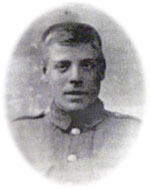
Private James Walters
Despite the heavy losses sustained during the war, the Sherwood Foresters won many battle honours for outstanding acts of bravery, including a number of Victoria Crosses and over 2000 other decorations, honours and distinctions. The cost to the Regiment was very high which is reflected on War Memorials throughout Nottinghamshire and Derbyshire. Nearly 11,500 men lost their lives fighting in the Great War. The youngest man in the Battalion to die was Private 25793 James Walters, on 9 August 1916 aged 17 years and is buried at Delville Wood in France. Private 22738 Fred Carter from Sutton in Ashfield has no known grave and is commemorated on the Thiepval Memorial to the missing.
The highest award given for bravery, The Victoria Cross, was given to a number of men of the Sherwood Foresters for acts of bravery during the First World War including the following:
- Private Jacob Rivers VC 1st Battalion Sherwood Foresters at Neuve Chapelle on 12 March 1915.
- Corporal James Upton VC 1st Battalion Sherwood Foresters near Rouges Bancs on 9 May 1915
- Captain Charles Geoffrey Vickers VC 1st/7th (Robin Hood) Battalion Sherwood Foresters at the Hohenzollen Redoubt on 14 October 1915
- Captain John Leslie Green VC Royal Army Medical Corps attached to 1st/5th Battalion Sherwood Foresters at Gommecourt on 1st July 1916.
- Captain Albert Ball VC DSO + 2 Bars MC 2/7th (Robin Hoods) Battalion Sherwood Foresters and 56 Squadron Royal Flying Corps. Awarded for his actions during air combat between 25 April and 6 May 1917.
- Corporal Ernest Albert Egerton VC 16th (Chatsworth Rifles) Battalion Sherwood Foresters At Bulgar Wood on 20 September 1917.
- Corporal Fred Greaves VC 9th Battalion Sherwood Foresters on 4 October 1917 at Poelcappelle in the Ypres.
- Lieutenant Colonel Charles Edward Hudson VC DSO + bar MC 11th Battalion Sherwood Foresters (Men from the Greenwood) On the San Sisto Ridge near Asaigo Italy on 15 June 1918
- Acting Lieutenant Colonel Bernard William Vann VC MC + Bar 1st/8th Battalion Sherwood Foresters Commanding the 1st/6th Battalion For most conspicious bravery, devotion to duty and fine leadership during the attack on Bellenglise and Lehaucourt on 29 September 1918.
- Sergeant William Henry Johnson VC 1st/5th Battalion Sherwood Foresters at Ramicourt on 3 October 1918.

Sergeant Johnson's Victoria Cross and other medals.
As well as these awards many of the regiment were awarded the Military Cross, Military Medal and DSO and bars alongside foreign awards such as Croix de Guerre awarded by the French military.
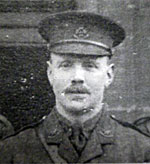
Captain T. P. Black
Many of the young men who served in the Sherwood Foresters were recruited from the University College Officer Training Corps. This organisation was made up of staff and students and 1600 cadets went to the Front, and over 200 died and 500 were injured. One of those who unfortunately never returned was Captain T P Black, who after a successful career as a lecturer in physics had been appointed Registrar of the College in 1911. He died in the Dardanelles in August 1915.
A famous son of Nottingham served in 11th Battalion, Sherwood Foresters, between 1915-1918. James A Woodford was born in Nottingham in 1893 and was educated at the Nottingham School of Art and Royal College of Art. He was elected a full member of the Royal Academy in 1945. Among his many important works are the statue of Robin Hood which stands outside the Nottingham Castle and the Queen’s Beasts, standing in the annexe of Westminster Abbey at the Coronation in 1953.
The Sherwood Foresters in the Easter Rising, Dublin 1916
In the centenary year of the Irish Uprising in Dublin, 1916, mention should be made of the important role that the Sherwood Foresters played in crushing the uprising.
Ireland had been under the control of the English until the Act of Union in 1801, when direct rule from Westminster began. The Irish parliament lost its legal independence. Over the next century several skirmishes occurred between armed Irishmen and the powerful English, and much discussion took place about Home Rule. At the beginning of the twentieth century a Home Rule Bill was brought before Parliament, but rejected. In 1912 another Home Rule Bill was introduced with the expectation that by 1914 it would have been passed. However with the onset of the Great War this never happened and the bill was lost.
During the first decade of the twentieth century a series of movements gathered momentum, both pro and anti-English. On one side the Orangemen of Ulster, who became the Ulster Volunteers who were opposed to Home Rule, and on the other the Irish Citizen Army and the Irish Volunteers who defended the ideal of “Home Rule”. With the outbreak of the First World War the Home Rule Bill was put on the back burner, which incensed the anti-English groups who wanted to force the issue, accepting help from any party, even the Germans.
Preparations began for an insurrection, which would start with the delivery of a consignment of guns and ammunition from Germany, organised by Sir Roger Casement, an Irishman who was anti-British. Unfortunately the boat carrying the cargo (the Libau, later renamed the Aud) was detained by the British navy. In an effort to thwart the British, the boat’s captain scuttled it and all the weapons were lost, which was a significant blow to the Irish Republicans. Confusion in the Irish camp over whether the proposed attacks were to take place in Dublin further increased the vulnerability of the nationalists.
It is at this point that the Sherwood Foresters became involved in what is now known as the Easter Rising. Whitehall had been informed of the impending insurrection and the government took immediate steps to support the government in Dublin. At this time most of the regular battalions of the Sherwood Foresters were in France fighting the Germans, so it fell to those troops still training in England to be deployed, notably the 178th Brigade of Sherwood Foresters, 59th Division made up of 2/5th, 2/6th, 2/7th and 2/8th battalions who had been training in and around Luton. They came together as the 178th (Sherwood Forester) Brigade of the 59th Division. Leave had been granted to many of the men because it was Easter but on 24th April 1916 the order was given to move. Men hurried back to camp and immediately were sent by train to Liverpool where they embarked on ships to cross to Dublin. Although there seems to have been some confusion at the beginning the soldiers must have realised on their arrival in Liverpool that they were not heading for Flanders but going to Ireland.
On arrival in Ireland they were deployed around Dublin and over the next few days were involved in the battle for Dublin. A full history of the battles can be found in The Sherwood Foresters in the Easter Rising Dublin 1916. The rebels finally surrendered on 29th April 1916 and the task of rounding them up began; the leaders were taken to Kilmainham Gaol and kept in solitary confinement; some refused to surrender and kept up actions designed to aggravate the round up. Many of the prisoners were sent to England and were housed in prisons around the country. During May 1916, the main leaders were hastily tried and sentenced to death by a firing squad, formed by men of the Sherwood Foresters. Sir Roger Casement was hanged in Pentonville prison on 3 August 1916.
Reportage of the events and the part played by the Sherwood Foresters in the newspapers is very positive. The Irish Times on 1 May 1916 praised the young soldiers who fought magnificently. The Nottingham Evening Post on the same day reported that for some of the troops it was a baptism of fire but all displayed a coolness and courage that was highly commendable. Other praise came from the Commander in Chief of Forces in Ireland, Sir J C Maxwell, who praised the very good work which was carried out like true soldiers at Balls Bridge on 26 and 27 April 1916. The Mayor of Nottingham, Councillor J G Small, told a Council Meeting that Nottingham was very proud of them (Sherwood Foresters) and the gallant way they had carried out their duties.
In total 31 Sherwood Foresters lost their lives and more than 145 were wounded during their time in Ireland. The first casualty was 2nd Lieut F C Dietrichsen who was shot dead within two hours of reaching the area around Northumberland Road, Dublin, he was a barrister-at-law in Nottingham. Others included, 2nd Lieut P V C Perry, killed on 26 April 1916 advancing on Mount Street Bridge, he was a partner in G H Perry, Boulevard Works, Nottingham and had been married only 6 weeks; Lance Corporal T H Chapman, killed when he stormed across in front of the Nurses Home, was a game keeper to Duke of Newcastle.
There was some talk of the 2/7th and 2/8th walking into an ambush on Northumberland Road but this has been refuted, inasmuch as, the men knew that the rebels were in this area. The 2/8th were recruited from Newark. Earl Manvers, re-elected as president of the Newark Conservative Association disputed the idea of the ambush and said that the Sherwood Foresters knew their objective before anyone was lost. However he wanted to reassure the people of Newark that they did more towards stamping out the rebellion than anyone else.
The film A Terrible Beauty (2013) is a good visual account of the events over Easter 1916. The Nottingham Evening Post has coverage of the events and the men who fought in the uprising from the end of April through to May 1916.
Soldiers of the Sherwood Foresters who were shot for desertion or cowardice on the Western Front during the First World War
[This section was initially instigated and researched by Tim Amos and written by Dr Denise Amos.]
Official statistics indicate that there were over 3,000 men subjected to the Army Act, 18811. In 1914, section 12 of said Act outlined the offence that prescribed and led to the majority of the executions between 1914 and 1918. However, about 90% of the death sentences passed during this period were commuted, including some for murder. Only 10% of those convicted, some 312 men, were executed at dawn.
Of these men there were eight men from the Sherwood Foresters (Notts and Derby Regiment) who were shot for alleged desertion, cowardice and quitting their post. As with many of those who were executed there was another side to their ‘offence’.
The first two men, both from the 17th Sherwood Foresters, 39 Division had only arrived in France on 7 March 1916. They were inexperienced and sent out on the night 3/4 July to raid German trenches, near to Aubers Ridge. They were led by NCOs and were out for about one hour twenty minutes. According to the diarist he recorded that the ‘raid had been most successful’. This assessment seems dubious as there was a total of 14 casualties from a complement of 50. The following night a party from the 17 Sherwood Foresters led by a lieutenant were sent out to recover three portable bridges abandoned from the night before. The battalion had been in the line for 25 days without a break and were in a jittery state. The bridges were only about 75 yards from the German line and when the call came, Private (15251) George Henry Lawton (Lowton)2 refused to go and remained in the fire trench. The following day the Brigadier-General congratulated the Sherwood Foresters on their gallant conduct. Lawton was charged with cowardice and wilful defiance. He received a sympathetic hearing and a recommendation for mercy. He told the court he had been buried for four hours after a shell had caused his dugout to collapse. He was subjected to a medical examination, although this did not reveal anything untoward. He was a married man of 36 years and had five children. He left a widow, Florence.
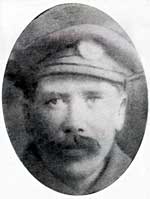
Private Bertie McCubbin
The second man to be found guilty of cowardice was Private (31821) Bertie McCubbin, a volunteer from Sutton in Ashfield. He was 22 years of age, born in 1893 in West Ham, Newham and was a mineral bottle washer and the 1911 census records him living at 16 Buckley Square, Ardwick, South Manchester. He was the eldest of six children and his father, William, was an asphalter.3 McCubbin was also in the 17th Sherwood Foresters, 39 Division. McCubbin’s offence was to refuse to go out into no-man’s-land to occupy a listening post. These posts were some way in front of the British lines and were often isolated and were therefore, stressful and debilitating. Once again, the comments by the senior officers did not match the conditions in the trenches; the fighting spirit shewn was excellent. McCubbin told the court in a letter he said, ‘During my stay in the Annequin trenches I had my nerves shattered by a shell which burst three yards away. I have not been right since….I have not been before my company officer or colonel before now…I have a father in France somewhere,4 leaving my mother at home with six brother and sisters….’ His company commander, Captain S F Brookfield said he had been with him for eight months and during the last six weeks he had become generally unsteady and unstrung. Nevertheless, he was found guilty and he was sentenced to face the firing squad but with a recommendation for mercy; the next day Brigadier Aldman recommended a 15-year prison sentence. However, further up the chain of command, General Sir Charles Monro5 commanding First Army supported the death sentence, commenting, ‘If toleration be shown to private soldiers, who deliberately decline to face danger, all the qualities, which we desire, will become debased and degraded.’ It was left to the most senior officer, Sir Douglas Haigh, to decide his fate, which he did by confirming the death sentence.
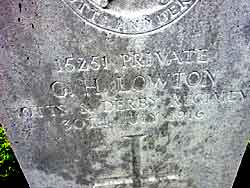
Detail of the grave marker to Private G. H. Lowton who was shot at dawn on 30 July 1916.
Both men were shot at dawn, at Lone Farm, on 30 July 1916. Unfortunately, McCubbin did not die instantly, the rifleman firing from close range failed to kill him and an officer had to despatch him from point-blank range with a pistol shot. Both were buried at Festubert, 8 km from Bethune.
The next unfortunate soldier to be shot was Corporal (23972) Jesse Wilton of the 15 Sherwood Foresters, 35 Division. He was 40 years old and born in Brownhills, Staffordshire, was married to Annie Elizabeth of 17 Brooking, Dunsdaille, Doncaster, and had 5 children. He was a coal miner, the son of a coal miner and in 1901 census he was recorded as boarding at Victoria Road, Rawmarsh, Doncaster. The Sherwood Foresters were facing the enemy trenches at Guillemont. There had been several attempts to proceed forward without success. Apparently, they had not eaten for several days and there had not been permission given for eating ‘iron rations.
Wilton and some others were ordered to take up a fairly exposed strategic position, in no-man’s-land, facing Guillemont, for a period of 48 hours. They were under heavy fire and six hours short of the allotted time, Wilton, ordered the evacuation of the post. Rumours spread about the reasons for this withdrawal but it was for the reason of fear for their lives in such an isolated position.
Wilton was court-martialled for quitting his post and sentenced to death, which duly took place on 17 August 1916. He is buried at Bray Military Cemetery, Bray sur Somme.
Private (70715) William Robinson, (no known date of birth or place of living), 1st Sherwood Foresters, 8 Division, was charged with desertion and shot at dawn on 10 April 1917, the day after the first battle of Arras. Little is known about the details of this man or the offence which he committed. He had gone absent at the beginning of March in order to avoid taking part in an attack. He was brought to trial towards the end of that month. There is no entry in the war diary for 1 Sherwood Foresters about the event taking place. He is buried at Peronne Communal Cemetery.
Private (73372) Richard M Davies, had initially enlisted in the Northamptonshire Regiment and had been sent to the Western Front in November 1915. At an unknown date he had been transferred to the 11th Sherwood Foresters, 23 Division, who were serving in Belgium. In the summer of 1917 were in action on the first day of the battle of Messines (7-14 June 1917) where a series of underground mines were laid and when they were detonated the effect of the mines blew the crest off the Messines-Wytschaete ridge. Audible in Dublin and by Lloyd George in his Downing Street study, the combined sound of the simultaneous mine explosions comprised the loudest man-made explosion until that point. The lighting up of the sky as the detonations ran across the ridge was likened to a 'pillar of fire'.6 At the end of September, the Foresters were heavily engaged and were attacked by the enemy using flame throwers. Davies deserted sometime in this period and was already on a suspended death sentence for a similar offence. He was captured and shot at Wizernes, near St Omer on 15 November 1917. Just before his division were sent to Italy. He is buried at Wizernes, Pas de Calais.
Private (13612) Frank O’Neill, born 1896, 24 years old was the last soldier to be unrepresented at his trial. He had joined the 1 Sherwood Foresters, 8 Division. He had a previous history of two convictions, one for desertion and one for violence (two years and then 18 months respectively). He had absconded from his battalion whilst his section was digging trenches. Four days later he was arrested wearing civilian clothing. He was sentenced to death. At the execution, the doctor officiating offered O’Neill a half pint of brandy, in order to render him oblivious to the event. O’Neill refused. He was shot at the village of Hermonville on 16 May 1918.He is buried at Hermonville.
The last Sherwood Forester to be executed was Private (21801) Arthur Briggs, born 9 April 1891 and was aged 27 years at his death. He was the son of Henry and Harriet Briggs, 7 Railway View, Locksfield Lane, Brimington, Chesterfield. His father was a hewer (coal miner) and Arthur was one of nine children. In the 1911 census he is recorded as married to Marjorie and a pony driver at the pit.
He had enlisted in the Notts and derby regiment in 1915 (9 Sherwood Foresters, 11 Division) and had been sent to Gallipoli. He had contracted dysentery and he had returned home and did not return to the Western Front until the end of 1916. His girlfriend (Marjorie) was pregnant and his parents opposed the marriage. On his return to France he had to wait for over a year until his leave was granted in January 1918. The marriage was still opposed but the couple married but with only a seven days’ leave pass he was desperate to find a home for his wife and child. At his court martial he maintained he had applied for an extension of leave. He was absent longer than he should have and taken his family to Scotland. He received a letter from his mother saying that his father and brother had both been killed in action and before he could return to her, he was arrested in Edinburgh wearing civilian clothing. He went back to France to face a court martial and was given the death penalty which was underlined by an uncompromising statement of his commanding officer deriding his value as a fighting officer. He was shot at dawn on 19 July 1918 in Hersin. He is buried at Hersin-Coupigny.
For the men executed at dawn, their ordeal was over after they had been shot, but for many of the men who were given the task of forming the firing squad, the effects lasted for much longer. The idea of a firing squad was to kill the man by shooting him, however, the firing squad did not possess even the first requirement of efficiency, namely, the certainty of causing immediate death. Nevertheless, there was a sketchy guideline as to what the procedure was to perform a firing squad, which was made up of the chaplain who explained to the prisoner what was going to happen, the assistant provost marshal in overall charge, and a medical officer to pronounce death. The firing party was made up of an officer, a sergeant and ten men of the prisoner’s unit who were forcibly detailed. The officer loaded the rifles and one would contain a blank – but any soldier would know which rifle contained the blank because there is a difference in its recoil. The officer would have a loaded pistol in case the prisoner was not killed outright by the firing squad.
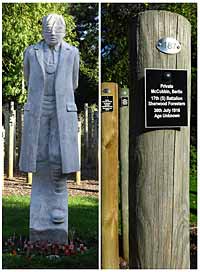 The Shot at Dawn section of the National Memorial Arboretum.
The Shot at Dawn section of the National Memorial Arboretum.The men mentioned above are remembered at the National Memorial Arboretum, near Alrewas in Staffordshire.
Pardons for soldiers executed for offences in WW1
On 18 September 2006, the then Secretary of State for Defence, Des Browne, announced that 306 soldiers executed at dawn for offences such as desertion, cowardice, mutiny and comparable offences committed during the period of hostilities from 4 August 1914 to 11 November 1918, were to be pardoned through the amendment to the Armed Forces Act 2006. (Includes those executed under the 1881 Army Act and the provisions of 1911 Indian Army Act.). Mr Browne stated he did not want “to second guess the decisions made by commanders in the field, who were doing their best to apply the rules and standards of the time", but that "it is better to acknowledge that injustices were clearly done in some cases, even if we cannot say which - and to acknowledge that all these men were victims of war". He went on to say that in each case, the effect of the pardon will be to recognise that execution was not a fate that the individual deserved but resulted from the particular discipline and penalties considered to be necessary at the time for successful prosecution of the war. Their convictions would not be quashed. It was not considered appropriate to include those executed for offences of murder and treason.
Later history
On 28th February 1970 the 1st Battalion The Sherwood Foresters (Nottinghamshire and Derbyshire Regiment) amalgamated with the 1st Battalion the Worcestershire Regiment to form the 1st Battalion, The Worcestershire and Sherwood Foresters Regiment (29th/45th Foot).
This entry concentrates only on the Sherwood Foresters and their participation in the First World War. For a complete history of the Sherwood Foresters go to their website www.wfrmuseum.org.uk or contact them at RHQ Mercian (Nottingham), Foresters House, Chetwynd Barracks, Chilwell, Nottingham NG9 5HA.
References
1. This Act was updated annually.
2. His name has been inter-changed with Lawton and Lowton on various documents.
3. The various addresses are probably down to the fact his father moved around the country for his job.
4. He was badly gassed while serving with the Royal Engineers and sent home. He died at the age of 51 years, six days after the Armistice was signed.
5. I believe this is the correct name and not Mayo as quoted in the Bygones article.
6. https://www.firstworldwar.com/battles/messines.htm